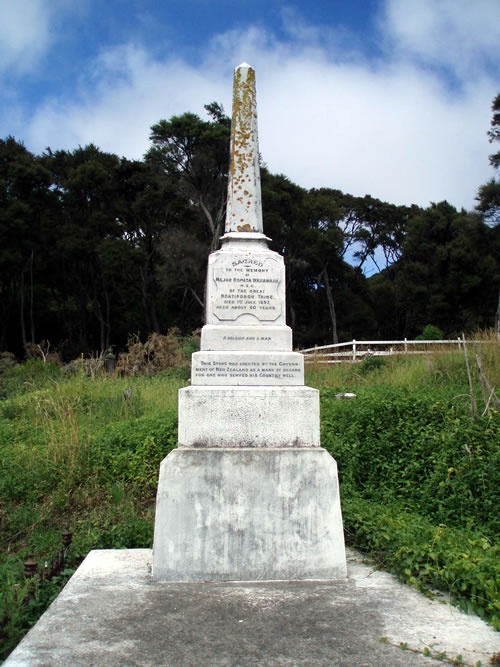
The Porourangi marae at Waiōmatatini is located on Waiōmatatini Road, 11 km north-east of the East Coast town of Ruatōria. This memorial obelisk stands in the urupā – burial ground – on the rocky outcrop of Puputa behind the marae’s wharenui. It is dedicated to the memory of Rāpata Wahawaha (died 1897) of Te Aowera hapū of Ngāti Porou. Rāpata’s great-nephew, Sir Apirana Ngata, is buried nearby.
During the New Zealand Wars, there was fighting on the East Coast between June 1865 and October 1866. Hostilities were provoked by the arrival of Pai Mārire supporters – Hauhau – in the region in early 1865, and especially by the killing of the missionary Reverend Carl Völkner in Ōpōtiki on 2 March. Ngāti Porou became split between those who supported Pai Mārire and those who did not.
Rāpata (also known as Rōpata) became a leading figure in the anti-Pai Mārire faction of Ngāti Porou. He was in his 50s when he became the leader of Te Aowera after Hēnare Nihoniho was killed fighting Hauhau adherents at Mangaone on 10 June 1865. In the years that followed, Rāpata proved to be an outstanding fighter with great personal courage and an ability to inspire his men.
After helping to drive the Hauhau from the East Coast, Rāpata fought in Poverty Bay. He demonstrated his tactical skill at Te Kopane, near Lake Waikaremoana, in January 1866, when he turned imminent defeat into victory. Rāpata led the pursuit of Te Kooti after the latter’s attack on Poverty Bay in November 1868. He was awarded the New Zealand Cross for his actions at Ngatapa on 5 and 6 December. Through 1870 and much of 1871, Rāpata led expeditions against Te Kooti in the Urewera Ranges.
For his services during the New Zealand Wars, Rāpata was awarded a sword of honour by Queen Victoria in 1878. He was later appointed officer in charge of the militia in the Ngāti Porou district, with a salary of £200 a year, and made an assessor to assist in law enforcement. He was appointed to the Legislative Council (the upper house of Parliament) in 1887 and received an annual pension of £100 in later life.
Rāpata’s death on 1 July 1897 was reported in newspapers around the country. His last advice to his people was to remain loyal to the Queen, friendly to Europeans, adhere steadfastly to the church and maintain their unity as a tribe.
Two days after his death, the Poverty Bay Herald began publishing the story of Rāpata’s life. The narrative, said to be of ‘thrilling interest’, was related by Rāpata’s friend and former comrade-in-arms Lieutenant-Colonel Thomas Porter. It ran to 16 instalments between 3 July and 7 September 1897.
Rāpata was buried on 13 July with full military honours. Porter, Major McCredie, Major Finn and Lieutenant Hislop acted as pallbearers. The Church of England burial service was read by the Reverend H. Williams, who was assisted by the Māori clergymen Matiaha Pahewa, Mohi Tūrei, Eruera Kawhia and Piripi Awarau. The government sent a firing party and the Gisborne Brass Band, and the attending dignitaries included Waiapu MP James Carroll and Eastern Maori MP Wiremu Pere.
The following year, the government erected this memorial obelisk over his grave as a mark of its respect. Created by J.W. Helyer of Wellington at a cost of £52 10s 8d, the memorial was completed in September and probably erected in early October.
Inscription
Sacred / to the memory / of / Major Ropata [Rapata] Wahawaha / N. Z. C. / of the great / Ngatiporou tribe. / Died 1st July, 1897, / aged about 80 years. / A soldier and a man. / This stone was erected by the Govern- / ment of New Zealand as a mark of regard / for one who served his country well.
Further sources
- Rapata Wahawaha biography
- ‘Obituary’, Poverty Bay Herald, 2 July 1897
- ‘Burial of Major Ropata’, Poverty Bay Herald, 15 July 1897
- ‘Local and General’, Evening Post, 24 September 1898
- ‘The Late Major’, Poverty Bay Herald, 26 September 1898
- [untitled], Poverty Bay Herald, 2 December 1899
- James Cowan, The New Zealand Wars: A History of the Maori Campaigns and the Pioneering Period: Volume II: The Hauhau Wars, 1864–72, R.E. Owen, Wellington, 1956.
- ‘Major Ropata’, The Cyclopedia of New Zealand [Auckland Provincial District], The Cyclopedia Company Limited, Christchurch, 1902, pp. 969–70
- J.A.B. Crawford, ‘Porter, Thomas William (1843–1920)’, Dictionary of New Zealand Biography, updated 22 June 2007
- Funeral of Wahawaha Ropata (image)
- Porourangi meeting house (image)


Community contributions